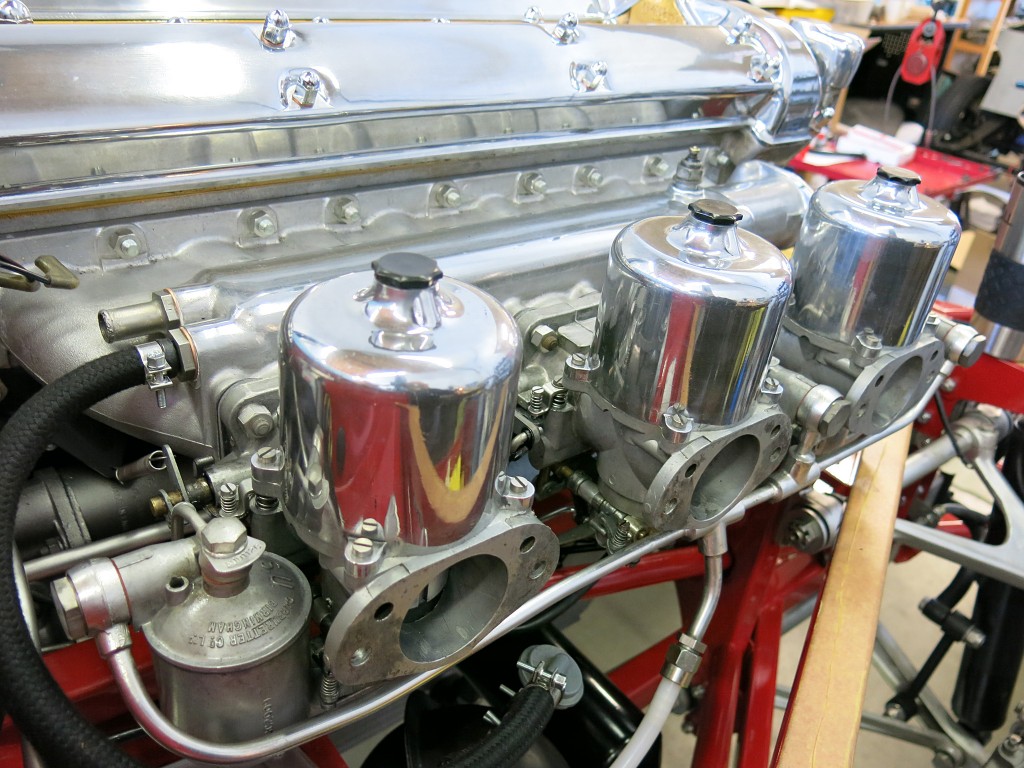
1967 Jaguar E-Type Intake
Ran across this SU Carburetor rundown on Facebook and it’s a great primer by Carl Heideman for Classic Motorsports:
http://classicmotorsports.com/articles/simple-carbs/
Hot tip on tuning:
However, before the carbs are touched, ignition dwell and timing must first be correct. It’s a good idea to ensure valve clearances are correct as well. A quick check for vacuum leaks is next, and only once this is done is it time to move on to the carburetors.
Tips by Mike Owen and compiled by Russ Cape. Originally article syndicated from “The Octagon” of Victoria MG Club newsletter:
It is time to get our LBCs back on the road now that the sunshine and warm weather has returned.
Fluids – The first thing is to check for any fluid leaks under the car. Check the oil, coolant and brake and clutch fluid levels. 1969-74 MGBs are prone to reservoir leaks. If the brake fluid is black and dirty, drain it and replace it. Silicone (DOT 5) fluid does not absorb water and is not susceptible to corrosion like regular brake (DOT 3 and 4) fluids.
Battery – Your next check should be the battery. If there is white powdery residue on the battery posts and connectors, remove the battery from the car and wash it down with a mixture of water and baking soda. [Some People] Apply vaseline to the posts and connectors. If the car has the helmet type connectors, watch for a worn, sloppy connection that could fail.
Starting – If the fuel did not include a stabilizer or if the gas has sat for a long time, replace the fuel. Old gas can be a problem because it can gum up the valves which can stick open after the engine is turned off. If the car has not been driven for a while, remove the spark plugs and turn the engine over until the oil pressure comes up. This helps because it reduces stress on the battery and starter. Replace the spark plugs and start the engine.
Clutch – The clutch can sometimes stick to the flywheel. This will be evident if it is difficult to put the car in gear. Start the engine and – very carefully – put the car in first gear. The car will jerk and the clutch should break free with a bang. Make sure there is enough space for the car to move forward. Apply the handbrake as well.
Lights – check the brake and signal lights to ensure they work. Some Triumphs [TR6] have bad connections on the rear lights.
Ignition – If the car does not start, check the distributor points – use emery paper to remove any corrosion. Next, test that there is spark from the coil. Do this by removing the high tension wire from the distributor cap. Hold it a ¼ of an inch from a fastener – a nut on the head – on the engine block with insulated pliers or tape it in place. Have an assistant turn the engine over and check if there is a spark. Do the same with each spark plug in turn. Do this by sticking the tip of an insulated screwdriver into the plug cap. If there is no spark at the spark plugs, the rotor is likely faulty. Ensure a new rotor is not the type with a brass rivet – these have been faulty.
Fuel system – If the car still does not start, the next step is to check the fuel system. Listen for clicking from the fuel pump when starting. If absent, clean the points in the fuel pump. The next step is to test the flow by disconnecting the fuel line where it connects to the carburettors. With the ignition on, the pump should fill a small coffee can in about 20 seconds. Another potential problem is green corrosion on the float needles. Next, remove the air filters and shoot a short shot of starting fluid – like “Ace Starting Fluid No. 735” – into the carburettors. Be very careful – this is compressed ether and is very explosive! Failing this, rebuild the carburettors.
Slow cranking – Sometimes the starter will draw all of the available voltage from the battery leaving nothing for ignition. Either charge the battery or get a second one and a set of jumper cables to generate ignition spark. Interestingly, Petronics systems have a super fast start.
Poor compression – One of the last possibilities is no compression in the engine cylinders because the rings are stuck. Shoot a squirt of engine oil into each cylinder to temporarily seal the rings. Once the engine is warm, the rings will free up. Another trick is to drain the cooling system and replace it with hot water to warm the engine and rings.
Brakes – Sticking brake cylinders are a common problem with cars in storage. This will cause the brakes to drag and heat up. Check that they are not binding. Jack the car up, apply the brakes and see if the wheel rotates freely. If the car has low mileage, setting up the adjusters should not be necessary. If the handbrake was applied overwinter and the shoes have rusted to the drums, either remove the drum and fiddle with the adjusters to break the seizure or strike the drum with a soft hammer to free up. A very common problem is old brake hoses that constrict the flow of fluid and cause the car to pull. A rupture in a hose is a bad thing, so replace them.
Tires – The final thing is to check the tire pressures before heading out on the road.

